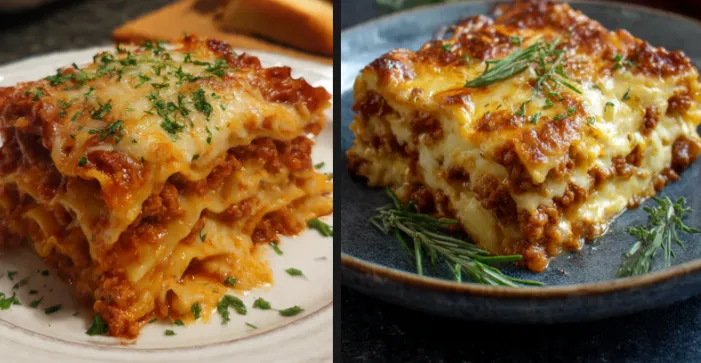Lasagna Bolognese is the ultimate Italian comfort food — rich, hearty, and deeply satisfying. With layers of tender pasta, slow-simmered meat sauce, creamy béchamel, and melted cheese, it’s a dish that brings warmth and joy to every table. Originating from Bologna, Italy, this version of lasagna is a true classic, known for its depth of flavor and luxurious texture.
The Essence of Lasagna Bolognese
Unlike American-style lasagna, which often uses ricotta and tomato-heavy sauces, traditional Lasagna Bolognese features a slow-cooked ragù made with ground meat, vegetables, wine, and milk, layered with silky béchamel sauce and fresh pasta sheets. The result is a perfectly balanced dish — rich but not heavy, creamy yet structured, and bursting with authentic Italian flavor.
Why Lasagna Bolognese Is So Special
Lasagna Bolognese stands out because it’s a labor of love. Each component — the ragù, the béchamel, the pasta — is crafted with care, then layered and baked to perfection. The slow-cooked sauce develops deep, complex flavors, while the béchamel adds a velvety smoothness that ties everything together.
It’s a dish that embodies the heart of Italian cooking: patience, quality ingredients, and the joy of sharing good food.
Ingredients and Their Roles
Ground beef and pork: Create a rich, flavorful base for the ragù.
Onion, carrot, and celery: The aromatic foundation of the sauce.
Tomato paste and crushed tomatoes: Add depth and body.
Red wine: Enhances flavor and richness.
Milk: Softens the acidity of the tomatoes and enriches the sauce.
Butter and flour: Form the base of the béchamel sauce.
Milk (for béchamel): Creates a creamy, smooth texture.
Nutmeg: Adds warmth and subtle spice to the béchamel.
Lasagna noodles: Provide structure and layers.
Parmesan cheese: Adds sharpness and umami.
Step-by-Step Recipe for Lasagna Bolognese
Ingredients
For the Ragù Bolognese:
- 2 tablespoons olive oil
- 1 tablespoon butter
- 1 onion, finely chopped
- 1 carrot, finely chopped
- 1 celery stalk, finely chopped
- 500 g (1 lb) ground beef
- 250 g (½ lb) ground pork
- 2 tablespoons tomato paste
- 1 cup red wine
- 1 ½ cups crushed tomatoes or tomato purée
- 1 cup whole milk
- Salt and pepper to taste
the Béchamel Sauce:
- 4 tablespoons butter
- 4 tablespoons all-purpose flour
- 4 cups whole milk, warmed
- ¼ teaspoon nutmeg
- Salt and pepper to taste
Assembly:
- 12 lasagna noodles (fresh or no-boil)
- 1 cup grated Parmesan cheese
- 1 cup shredded mozzarella (optional)
Preparation
1. Make the Ragù Bolognese
- Heat olive oil and butter in a large pot over medium heat.
- Add onion, carrot, and celery. Cook for 5–7 minutes until softened.
- Add ground beef and pork. Cook until browned, breaking up the meat with a spoon.
- Stir in tomato paste and cook for 2 minutes.
- Pour in red wine and simmer until mostly evaporated.
- Add crushed tomatoes and milk. Season with salt and pepper.
- Reduce heat to low and simmer uncovered for 1½ to 2 hours, stirring occasionally, until thick and rich.
2. Make the Béchamel Sauce
- In a saucepan, melt butter over medium heat.
- Whisk in flour and cook for 1–2 minutes to form a roux.
- Gradually whisk in warm milk, stirring constantly until smooth.
- Simmer for 5–7 minutes until thickened.
- Season with salt, pepper, and nutmeg.
3. Assemble the Lasagna
- Preheat the oven to 190°C (375°F).
- Spread a thin layer of béchamel on the bottom of a 9×13-inch baking dish.
- Add a layer of noodles, followed by ragù, béchamel, and a sprinkle of Parmesan.
- Repeat the layers until all ingredients are used, finishing with béchamel and Parmesan on top.
- Add mozzarella if desired for extra cheesiness.
4. Bake
- Cover with foil and bake for 25 minutes.
- Remove foil and bake for another 15–20 minutes until golden and bubbling.
- Let rest for 10–15 minutes before slicing.
Tips for Perfect Lasagna Bolognese
- Simmer the sauce slowly: The longer it cooks, the richer the flavor.
- Use fresh pasta if possible: It absorbs the sauces beautifully.
- Don’t skip the milk in the ragù: It softens the acidity of the tomatoes.
- Layer evenly: Ensures balanced flavor and texture in every bite.
- Rest before serving: Allows the layers to set for clean slices.
Variations to Try
Classic Lasagna alla Bolognese
Stick to tradition with only ragù, béchamel, and Parmesan — no mozzarella.
Spinach Lasagna Bolognese
Add a layer of sautéed spinach between the sauces for extra color and nutrition.
Mushroom Bolognese Lasagna
Replace half the meat with finely chopped mushrooms for a lighter, earthy version.
Vegetarian Lasagna Bolognese
Use lentils or plant-based meat alternatives in place of beef and pork.
White Lasagna
Skip the tomato sauce and use béchamel with chicken, mushrooms, and spinach.
Serving Suggestions
Lasagna Bolognese pairs beautifully with:
- A crisp green salad with vinaigrette
- Garlic bread or focaccia
- A glass of red wine such as Chianti or Sangiovese
For presentation, garnish with fresh basil or parsley and a sprinkle of Parmesan.
Storage and Make-Ahead Tips
- Make-ahead: Assemble the lasagna up to 24 hours in advance. Cover and refrigerate until ready to bake.
- Leftovers: Store in an airtight container in the refrigerator for up to 3 days.
- Freezing: Freeze unbaked or baked lasagna for up to 2 months. Thaw overnight before reheating.
- Reheating: Warm in the oven at 180°C (350°F) until heated through.
Nutritional Information (per serving)
- Calories: 480–550 kcal
- Protein: 30 g
- Fat: 28 g
- Carbohydrates: 32 g
- Fiber: 3 g
- Sodium: 620 mg
The History and Inspiration Behind Lasagna Bolognese
Lasagna Bolognese originates from the Emilia-Romagna region of Italy, particularly Bologna — the birthplace of ragù alla Bolognese. The dish dates back to the Middle Ages, evolving from layered pasta dishes made with meat and cheese. Over time, it became a symbol of Italian home cooking, representing comfort, family, and tradition.
Today, it remains one of Italy’s most beloved dishes, celebrated for its rich flavor and satisfying layers.
The Texture and Flavor Profile
The perfect Lasagna Bolognese has a harmonious balance of textures — tender pasta, creamy béchamel, and hearty ragù. The flavors are deep and complex, with the sweetness of the vegetables, the richness of the meat, and the subtle nuttiness of Parmesan.
Each bite is a comforting blend of savory, creamy, and slightly tangy notes.
Troubleshooting Common Issues
Watery lasagna: Simmer the ragù until thick and let the lasagna rest before slicing.
Dry lasagna: Add a bit more béchamel or sauce between layers.
Burnt top: Cover with foil if it browns too quickly.
Undercooked noodles: Use fresh or pre-cooked pasta sheets.
Chef’s Tips for Professional Results
- Use high-quality ingredients: Fresh pasta, real Parmesan, and good wine make a difference.
- Layer strategically: Start and end with béchamel for a creamy finish.
- Bake uncovered at the end: Creates a golden, crisp top.
- Let it rest: Essential for clean, beautiful slices.
- Serve warm, not hot: Enhances flavor and texture.
Pairing Ideas
- With Beverages: Pair with Chianti, Barbera, or a full-bodied Merlot.
- With Sides: Serve with roasted vegetables or Caesar salad.
- With Sauces: Drizzle with extra béchamel or a touch of olive oil before serving.
The Joy of Making Lasagna Bolognese
Making Lasagna Bolognese is a rewarding process — from simmering the sauce to layering the ingredients, it’s a dish that invites patience and care. The aroma of slow-cooked ragù and bubbling cheese fills the kitchen with warmth and anticipation.
It’s a recipe that brings people together, turning a simple meal into a celebration.
The Science Behind the Layers
The magic of lasagna lies in its layers. The starch from the pasta absorbs moisture from the sauces, binding everything together. The béchamel’s fat content creates a creamy texture, while the ragù’s proteins and sugars caramelize during baking, deepening the flavor.
The result is a perfectly cohesive dish where every layer complements the next.
Presentation and Garnishing
For an elegant presentation, slice the lasagna neatly and serve on warm plates. Garnish with fresh basil, parsley, or a sprinkle of Parmesan. Serve with a drizzle of olive oil for a glossy finish.
The Perfect Comfort Dish
Lasagna Bolognese is the epitome of comfort food — rich, hearty, and deeply satisfying. It’s perfect for family dinners, holidays, or any occasion that calls for something special.
Its layers of flavor and texture make it a timeless favorite that never fails to impress.
The Comfort of Tradition
This dish embodies the heart of Italian tradition — simple ingredients transformed through time and care into something extraordinary. It’s a recipe passed down through generations, bringing warmth and connection to every table.
Creative Twists for Modern Palates
For a modern twist, try adding roasted vegetables, truffle oil, or a layer of ricotta-spinach filling. For a lighter version, use turkey or chicken instead of beef and pork. You can even make a gluten-free version with gluten-free pasta sheets.
Each variation keeps the essence of the dish — rich, layered, and comforting — while adding a personal touch.
The Perfect Balance of Richness and Comfort
Lasagna Bolognese achieves the ideal balance of richness, creaminess, and depth. The ragù provides hearty flavor, the béchamel adds smoothness, and the pasta ties it all together.
It’s a dish that feels both indulgent and familiar — a true celebration of Italian comfort food.
Conclusion
Lasagna Bolognese is a timeless classic that captures the essence of Italian cuisine — simple ingredients, slow cooking, and layers of flavor. With its rich meat sauce, creamy béchamel, and tender pasta, it’s a dish that brings comfort, warmth, and joy to every bite.
Whether served for Sunday dinner or a festive occasion, Lasagna Bolognese is more than a meal — it’s a tradition, a labor of love, and a celebration of everything that makes Italian food so beloved.






